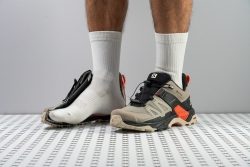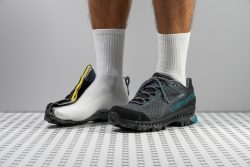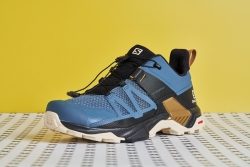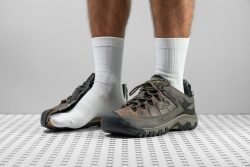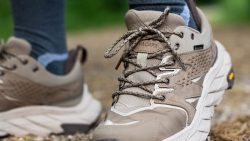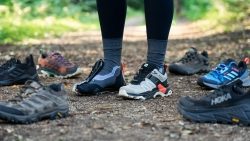4 Best Backpacking Shoes in 2025
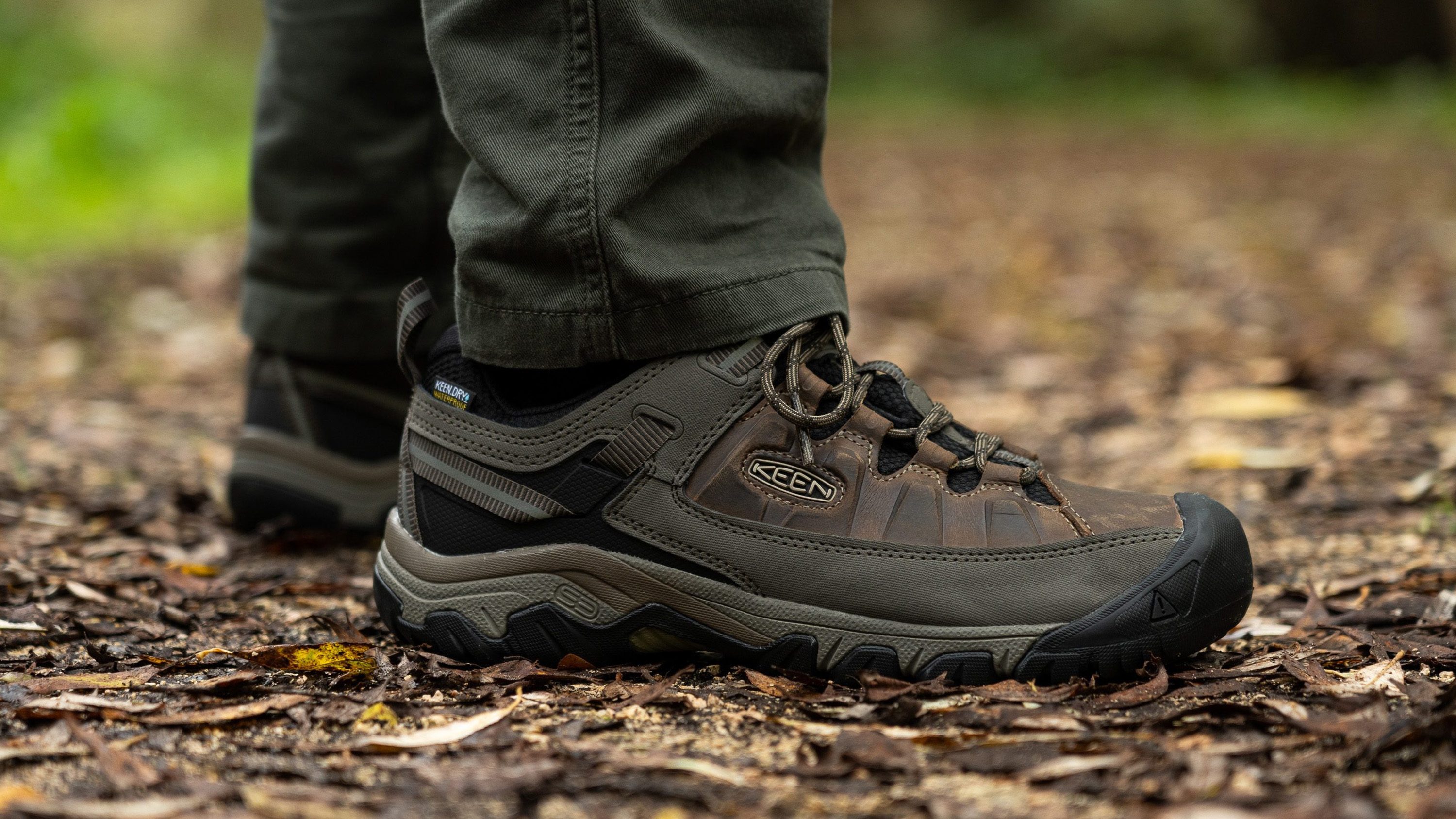
We buy shoes ourselves. We earn commissions when you buy through us, at no extra cost. Why trust us
Where the trail turns for the worse, but mobility is still high on your hiking preference list, turn to backpacking shoes. Especially when wearing a heavy backpack.
After backpacking in the shoes and testing them in our lab, we have chosen our top picks in several categories. Do you need a hiker that excels on and off the trail? Maybe something quite light to give you enough agility on your way? Or perhaps a backpacking boot that dances to the tune of your humble budget? We've got you covered.
How we test backpacking shoes
We put backpacking shoes through a series of tests to deliver unbiased reviews. Here are the details of our workflow:
- We buy every pair of hiking shoes with our own money. We don't owe it to anyone to write something.
- We spend days trekking on a variety of terrain in both dry and wet conditions to test each hiking shoe.
- We take the shoes to the lab where we use durometers, calipers, a smoke machine, gel molds, and other tools to measure 20+ parameters. In the process, we also cut the shoes in half. We analyze the results and compare them to averages.
Best backpacking shoes overall
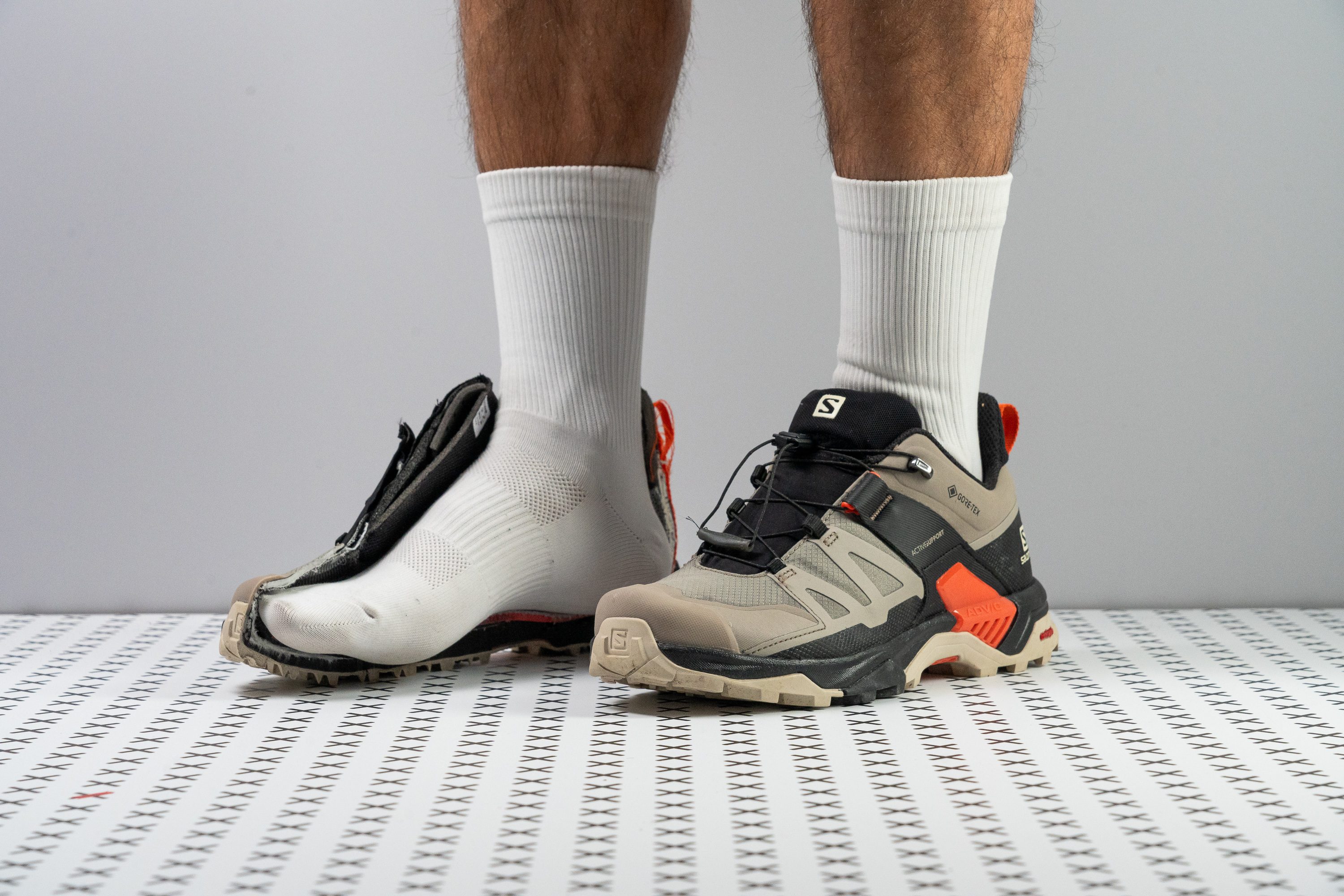











































What makes it the best?
Salomon X Ultra 4 GTX blends the best elements of trail and hiking shoes into one ultimate backpacking shoe. The light and flexible shoe made us feel agile while the grip and protection we experienced were similar to hiking boots. Our lab agrees this pair has the power to go through demanding trails and is not afraid of wet conditions.
We’re amazed at how light this shoe is despite packing so much support, grip, and protection into its build. At 13.3 oz (378g), it’s even lighter than the average trail shoe! It feels incredibly comfortable from the start since its malleable midsole promotes our natural strides. Our bend test confirms its flexibility between a trail and a hiking shoe.
The ride feels stable primarily due to the Active Support system that’s connected to the Quicklace system to prevent foot twists and ankle rolls. Further enhancing our control over unpredictable terrain is the deep and sticky 4.5 mm lugs.
Fully protected from harsh elements, the shoe's synthetic overlays and watertight upper offer top-notch defense. Alongside the Gore-Tex membrane, its tightly packed textile and durable water-repellent coating ensure minimal breathability, earning a 1/5 rating in our lab tests. While it effectively keeps out cold air and moisture, caution is advised against submerging the shoe completely, as water may not easily escape if it enters through the shoe mouth.
Pros
- Instant comfort
- Impeccable waterproofing
- Very lightweight
- Great grip for mixed terrain
- Excellent support and lockdown
- Stable platform
- True-to-size fit
Cons
- Minimal shock absorption
- Quicklace is not for everyone
- Too-high collar
Backpacking shoes with the best support
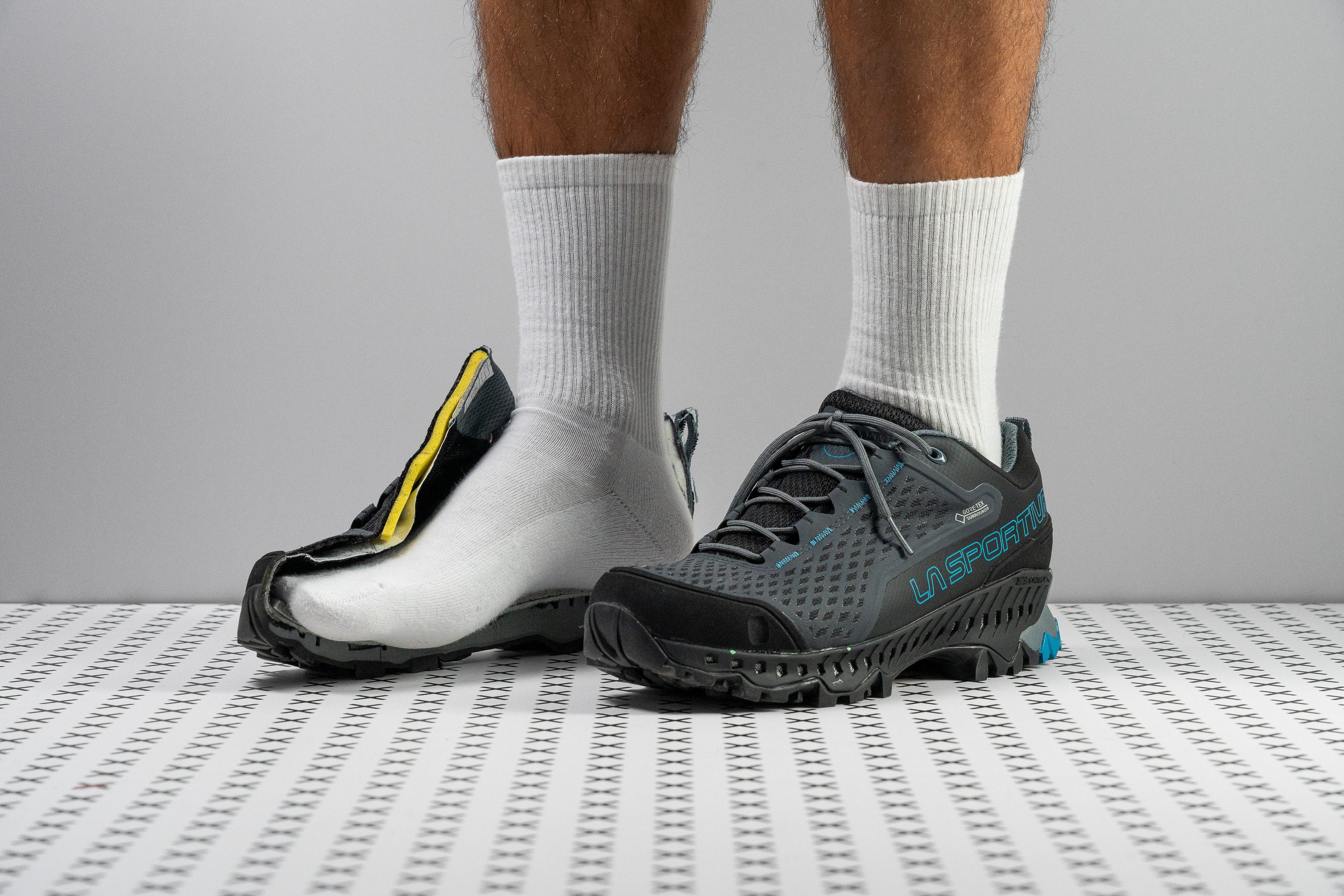





















































What makes it the best?
The La Sportiva Spire GTX felt like a boot without a high collar, thanks to its exceptional stability and all-around protection during our hikes. Among all the backpacking shoes we lab-tested, this one excels in support. We couldn’t feel the rocks below and the water seeping in above no matter where the paths led us.
Our feet felt highly isolated from the ground and our lab measurement revealed a massive chunk of foam under our heels: 39.1 mm! That’s 7.2 mm above average! The shoe also has a steep 16.0 mm heel drop making it very suitable for carrying heavy loads on longer distances.
To enhance stability, the foam has a firm rating of 32.6 HA, preventing any collapse. Moreover, Spire GTX features the STB control system, which consists of tall sidewalls that cradle our feet securely. Even underfoot, the Vibram outsole and deep 4.3 mm lugs ensure our safety even on steep and slippery terrains.
No matter how cold and wet the environment got, we stayed safe inside the upper that had synthetic overlays for protection. Though it scored 1/5 in our breathability test, which cements its watertight nature, it never felt too stuffy in the shoe as our body heat could still escape.
However, this supportive shoe costs $209, 63.3% more than the average hiking shoe—almost the price of a hiking boot!
Pros
- Feels like a backpacking boot with low collar
- Unparalleled stability and support
- Superb waterproofness with some breathabilty
- Mutes out rocks and debris like no other
- Excellent grip and braking
- Sturdy and durable construction
- Greater range of sizes allows to fine tune the fit
Cons
- Can feel tippy on rocky and hilly terrain
- Frail inner lining
- Gets even firmer in cold
Best backpacking shoes for summer
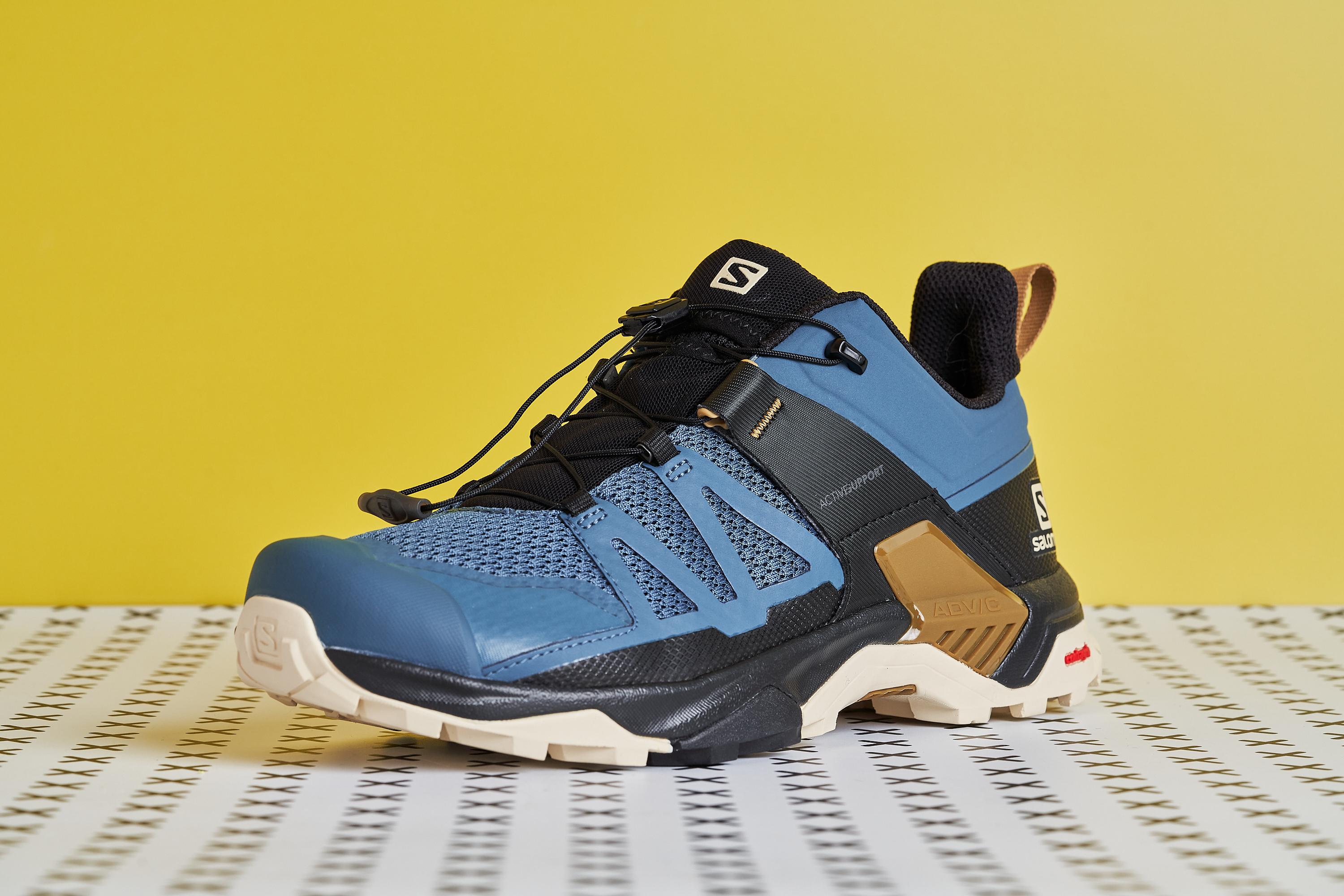


















What makes it the best?
Salomon X Ultra 4 delivers a stable and cushioned ride that feels comfortable for long hours. Even with its supportive nature, it remains exceptionally light and is topped with a breezy upper that keeps us feeling fresh for all-day adventures. This crossover between a hiking shoe and boot is our top backpacking shoe for the summer.
The mesh upper feels exceptionally well-ventilated, keeping our feet dry and comfortable even under the scorching heat of the sun. Whenever our feet would get wet, it would dry up quickly as well. The absence of waterproofing also shows its breathable nature.
Packed with padding and support, it weighs light at 12.5 oz (355g). Our feet reveled in the dual-density cushioning, featuring a balanced 46.0 HA in the forefoot for comfort and a firmer 51.5 HA in the heel for stability and underfoot protection. This helps avoid uneven compression under heavy loads.
Further enhancing our surefootedness is the ADV-C Chassis that connects the lacing system to a shank in the midfoot area to avoid excessive rolls. On foot, it feels very supportive. The Contagrip outsole does wonders to keep our movements controlled. It’s lined with 41 lugs that are 5.2 mm deep for extra traction on mixed surfaces.
However, the high heel counter causes rubbing at first in the ankle and Achilles areas. Those who prefer lower heel counters can explore further.
Pros
- Lightweight
- Exceptional breathability
- Excellent grip
- Comfortable midsole
- Great ankle support
- Insanely protective
Cons
- Lacing system is not adjustable
- Some issues with rubbing at the ankle
Backpacking hiking shoes with the best comfort
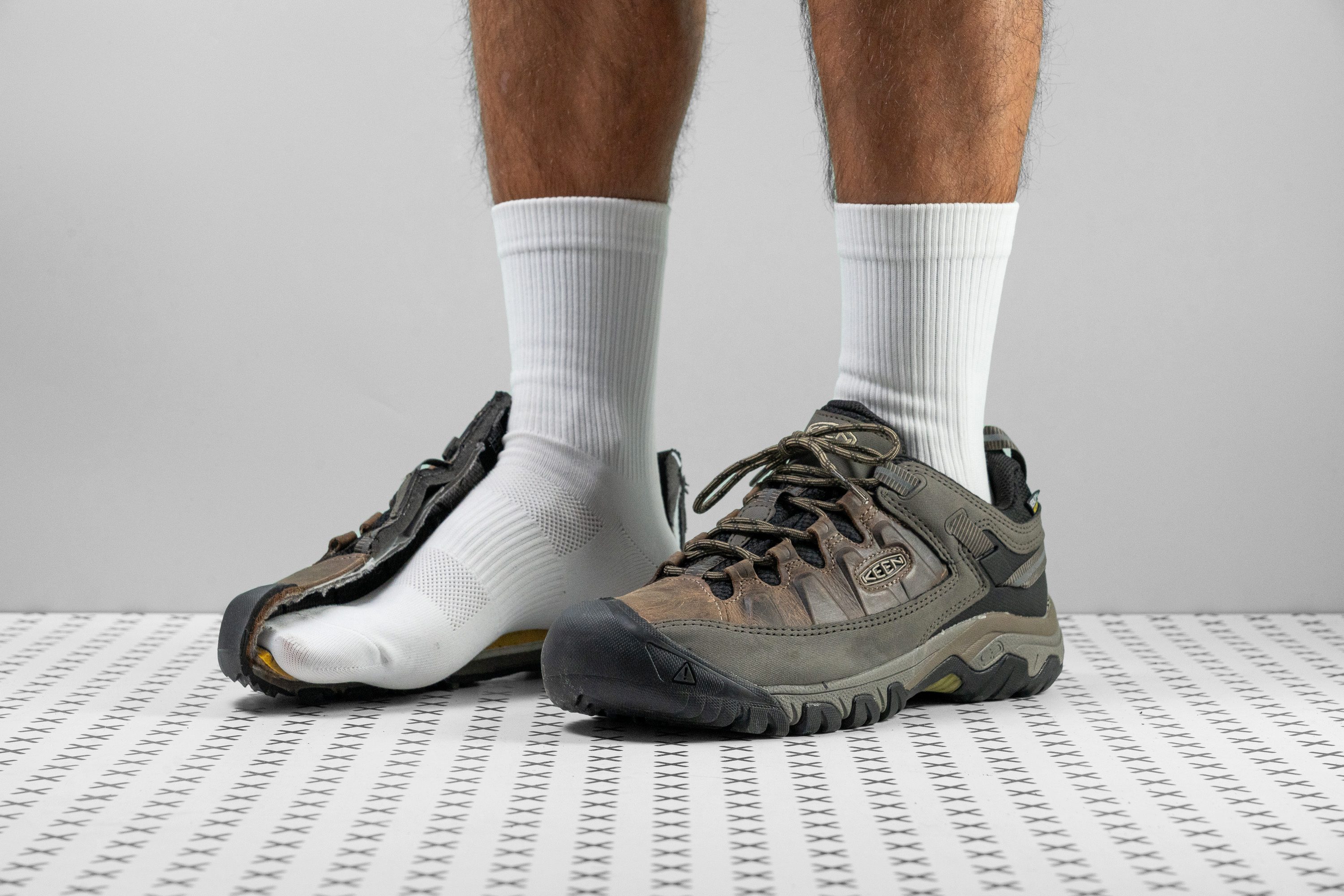














































What makes it the best?
We backpacked on mixed terrains with the best shoes and found solace in KEEN's Targhee III Waterproof, offering unmatched comfort for long hikes. It offers a supportive ride with its spacious and tank-like build, balanced cushioning, and robust lugs for tackling any terrain confidently.
The 29.5/17.0 mm heel and forefoot offer a healthy mix of cushioning and ground feel. The ride feels extremely stable on any terrain, thanks to the firm cushion that supports us even if we’re schlepping backpacks. Our durometer confirms it’s 11.9% denser than average, ensuring it won’t compress unevenly.
The accommodating toe compartment gives us comfortable wiggle room, as our caliper reveals a wide 106.6 mm toe box that gently tapers to the 86.6 mm big toe area. On top, we’re shielded by the robust upper that safeguards us from water and debris. Our lab confirms its protective nature with a 2/5 breathability rating and the highest rating for toe-box durability.
The 4.5 mm multi-directional lugs on the outsole provided reliable grip on various surfaces, from soft to hard, dry to wet. With a thick 3.3 mm rubber, the outsole offers both underfoot protection and durability for extended use.
However, its waterproofing is only effective until ankle level due to its low-cut nature. We recommend exploring boots for trails with deeper water levels.
Pros
- Excellent for winter hikes
- Firm but protective cushioning
- Well-constructed and durable upper
- Lots of protective overlays
- Amazing stability
- No break-in time
Cons
- Outsole durability could be better
- Not ideal for narrow feet
- Lacks traction on wet rocks
When to use backpacking shoes
When you’re going backpacking over not-too-demanding terrain, usually on 1-2 day trips. When the hike becomes very serious, the terrain uneven and technical, maybe it lasts a few days, and you’re wearing a very heavy backpack, best to go for backpacking boots. A bit easier trails can be covered in backpacking shoes as long as you’re OK with not having that ankle support that only boots give.
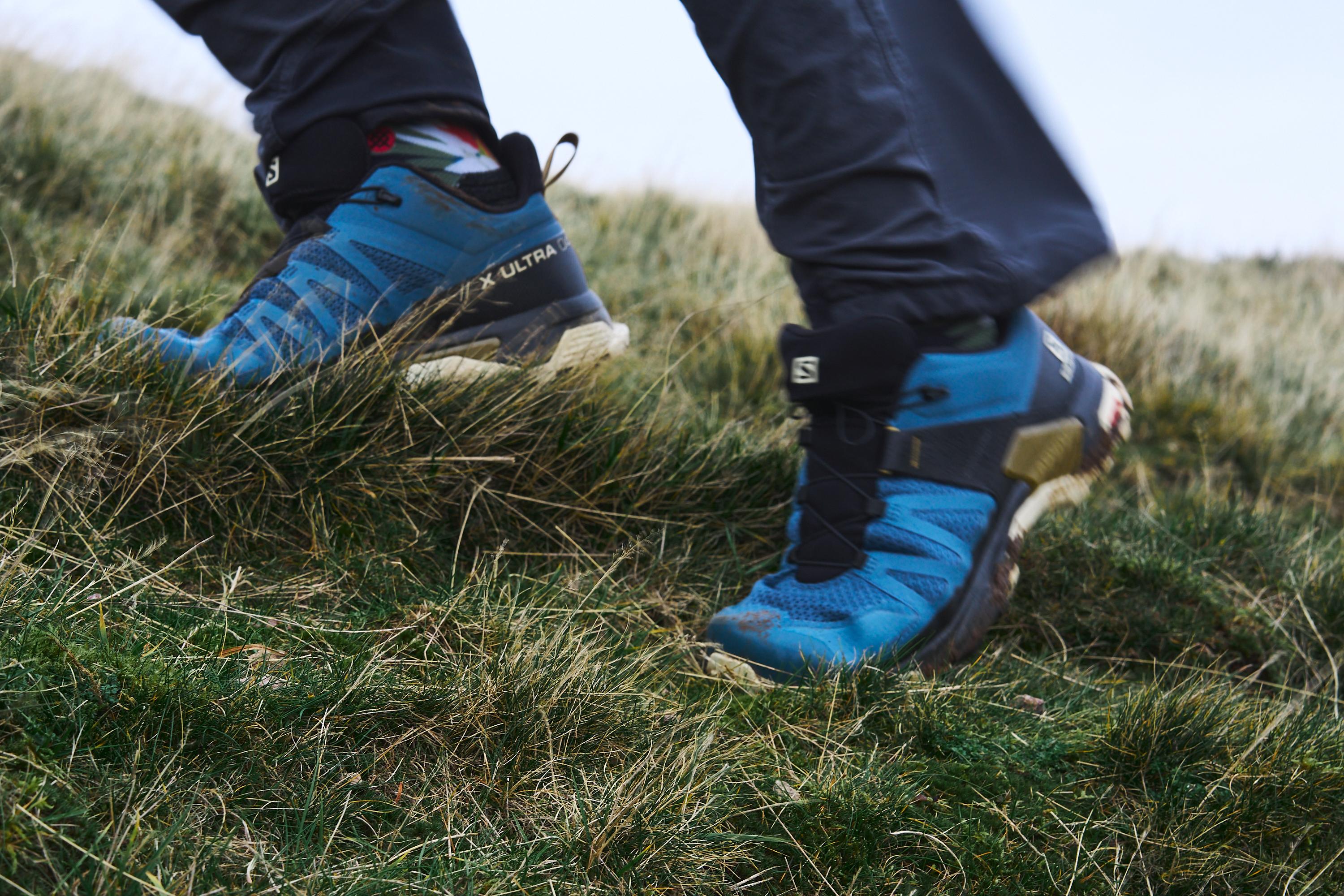
3 features that make backpacking shoes stand out
In all hiking shoes, we recommend looking for the protection and grip you need for the hike ahead. In backpacking shoes, it is imperative to look for:
- Average or firmer midsoles with good shock absorption. Midsoles that are too soft can be very unstable + they can sink in and bottom out, which results in premature foot fatigue to start with (best case scenario).
- Average or stiffer platforms. This is important because shoes that are too flexible can tire you out and not offer the support you need from the footwear. Also, stiffer shoes bend less over technical terrain.
- Stability! It’s all about not twisting your ankles and feeling secure on the hike. We examine the lateral stability and measure the width of the base: wider bases are more stable than the narrow, tall ones.
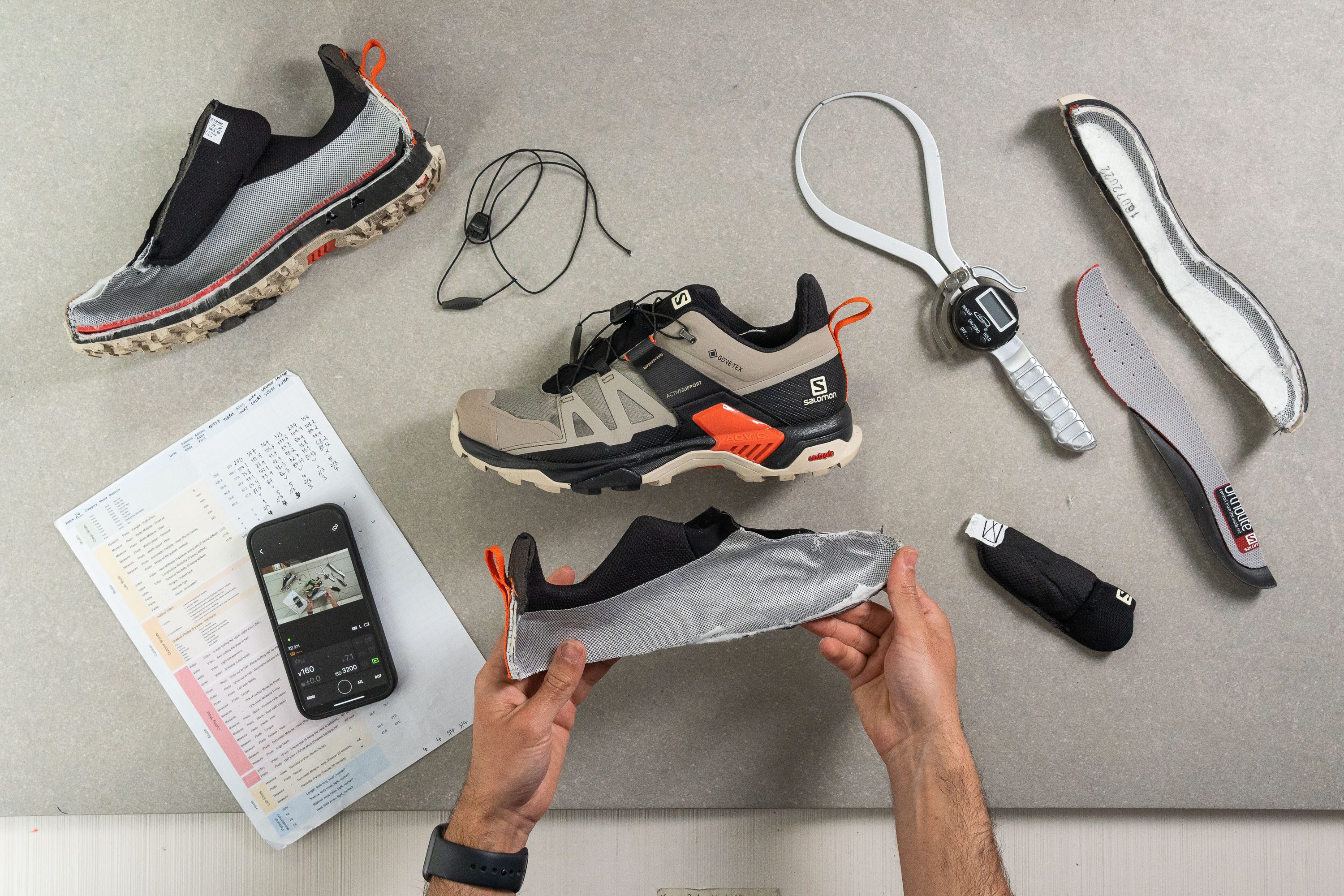
Thanks to our standardized lab tests and extensive wear tests, we’re able to cover all of these features in great detail and back them up with our lab data down below.
Nail the fit in backpacking shoes
If this is not your first time buying hiking shoes, feel free to skip this section.
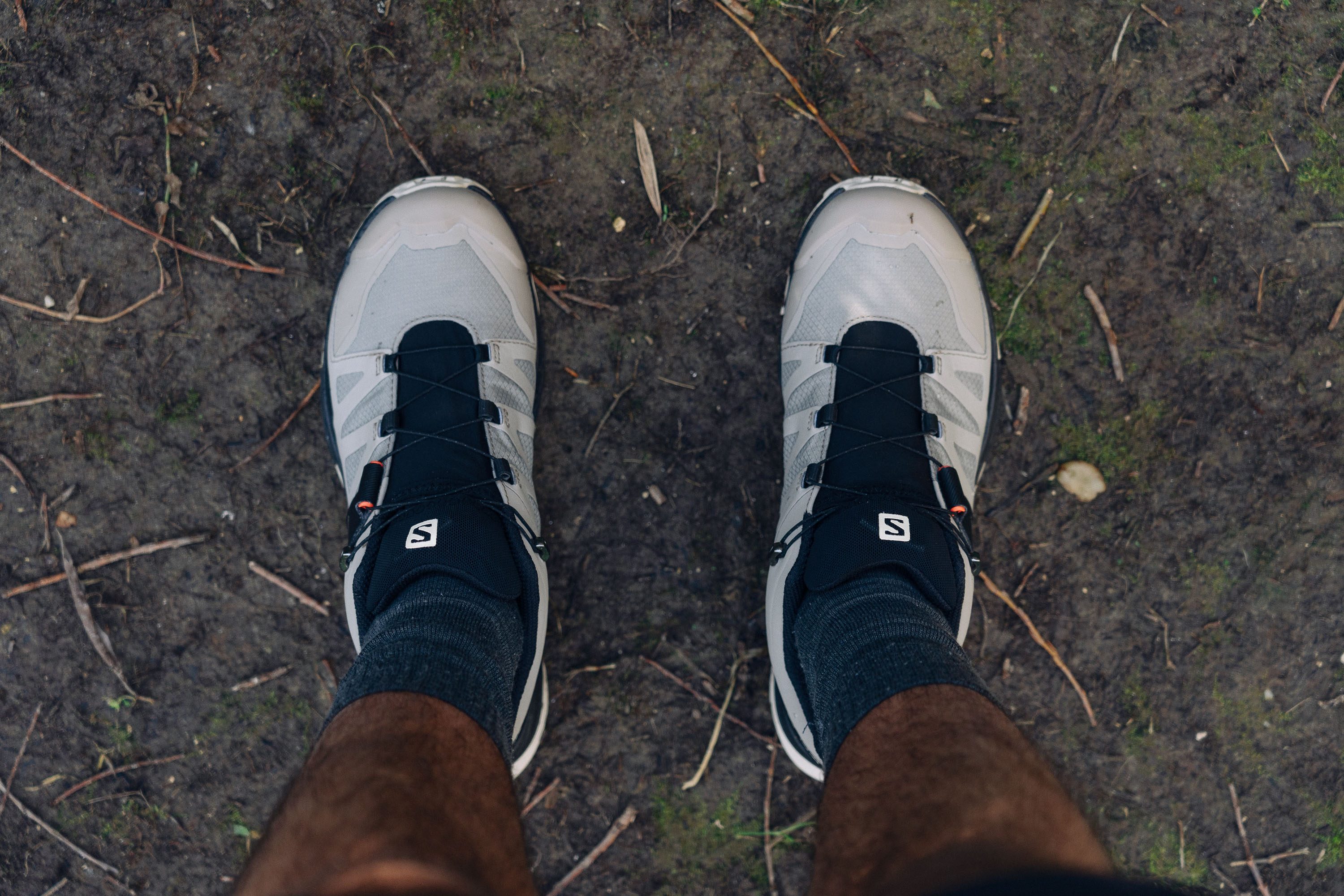
If you’re new to hiking, we strongly recommend sticking to these guidelines:
- Go shopping later in the day, in the evening or in the afternoon. We’re aiming for swollen feet, something that naturally happens towards the end of the day, and also when hiking.
- Bring your hiking socks with you. Orthotics as well, if you’re using them.
- Put the shoes on and make sure there’s one thumb’s width of space behind your heel when you push the foot forward.
- Test the shoes on the ramp, if there is one. It’s usually covered with different materials like artificial grass, pebbles, and rocks. Go up and down.
- There should be no heel slipping.
- Your feet should not be sliding to the sides inside the shoe.
- The shoes should be comfortable: not too snug and not too wide!
Before the first hike, especially if it’s a long one, make sure to brake in these shoes properly.
Firmer midsoles and good shock absorption
For backpacking, firmer midsoles are better than softer midsoles. The firmer ones offer more support and are more protective. Softer ones can bottom out and cause pain in your feet and lower legs, especially if your backpack is very heavy.
Testing the softness of the midsole on the test hike
To examine the softness, we press a durometer into the midsole of a shoe we’ve cut in half. The lower the number on it, the softer the midsole.

We test the shock absorption using a specialized machine and following the ASTM F1976-13 methodology. This means that every hiking shoe gets an identical treatment.
Testing the shock absorption of backpacking boots in RunRepeat lab
More shock attenuation means more protection and less (extra) work for the legs. What's not to love?
Why stiffer platforms are better for backpacking
Flexible footwear is better because it allows a more natural foot movement. However, when backpacking, you’re carrying a backpack and you might be covering terrain covered with rocks, debris, or simply a lot of uphills and downhills. In this case, it is better to hike in stiffer shoes. They don’t allow that much of the movement and that actually feels supportive.
In the lab, we use a shoe stiffness-testing machine to measure how stiff their platforms are.
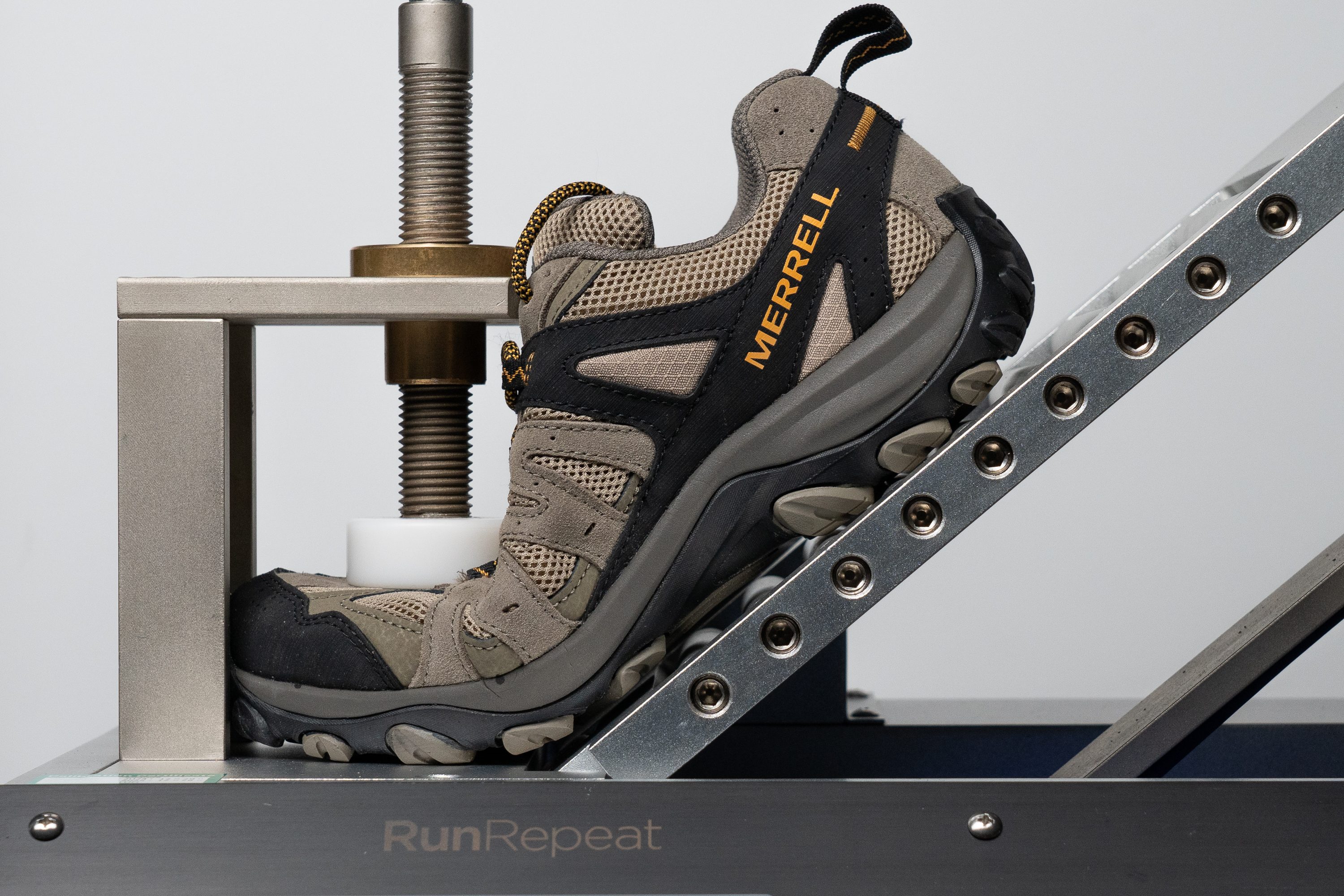
We measure how much force is needed to bend the shoe 30 degrees. More force needed = stiffer the hiking shoe!
We don’t stop there. We also assess the torsional rigidity! Those that are scored 5/5 are as rigid as it gets, unlike those that score 1/5 (most flexible).
Assessing the torsional rigidity of a backpacking shoe
Stability to the MAX!
Stability matters a lot when pebbles, rocks, debris, roots, and any other obstacles come into the equation. No one wants a twisted ankle. When doing test hikes, we always check the lateral stability: how the backpacking shoe feels and performs.
Lateral stability check on the test hike
But, what we can actually measure here, is the width of the platform. When a hiking shoe has a tall and narrow platform, it’s a great recipe for disaster. Fortunately, that is not often the case. But, we’d want it wider and, therefore, more stable.
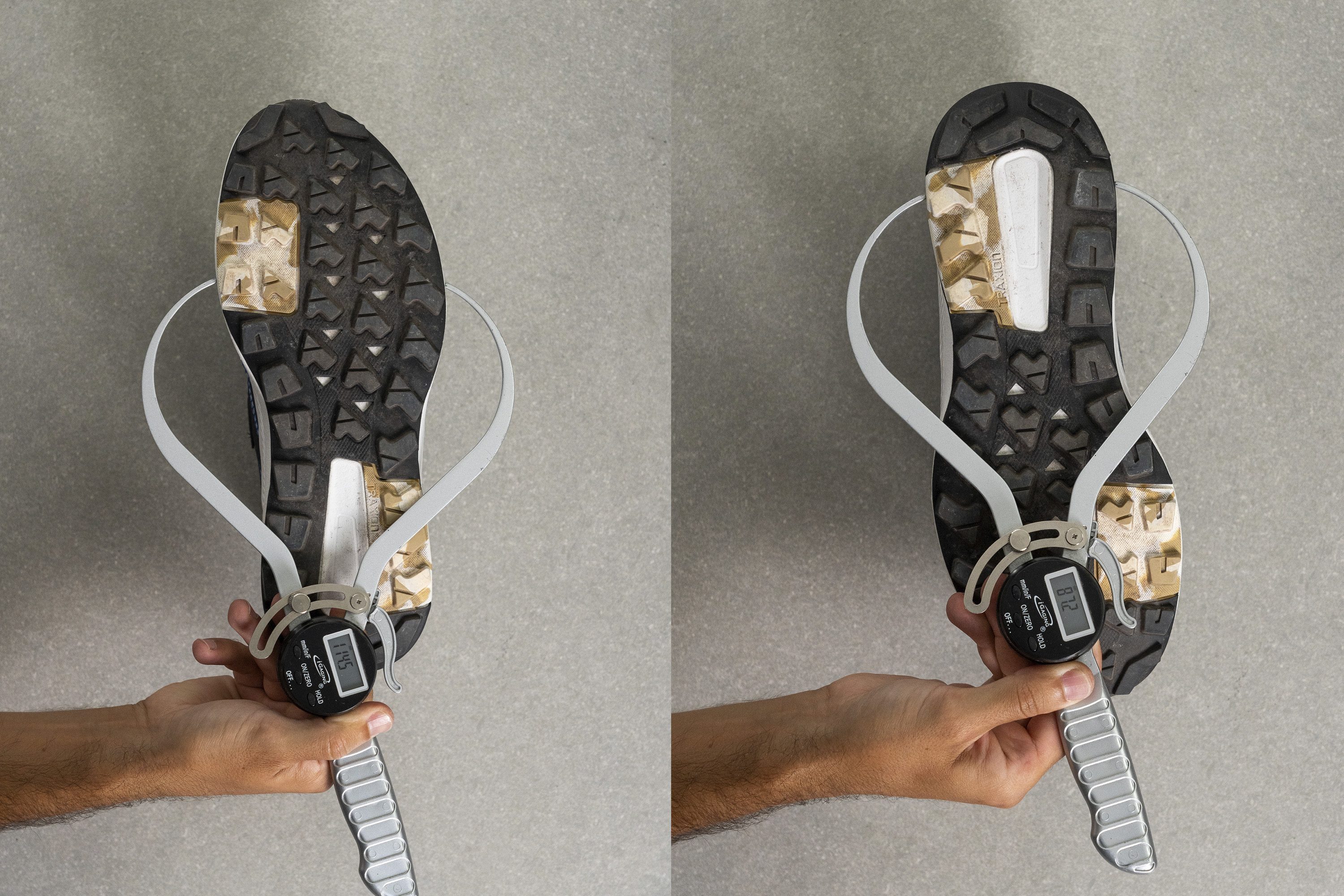
Even heel counters can be stiff!
Some hikers might not enjoy this, but if you like that extra supportive feel, look for a stiff heel counter.
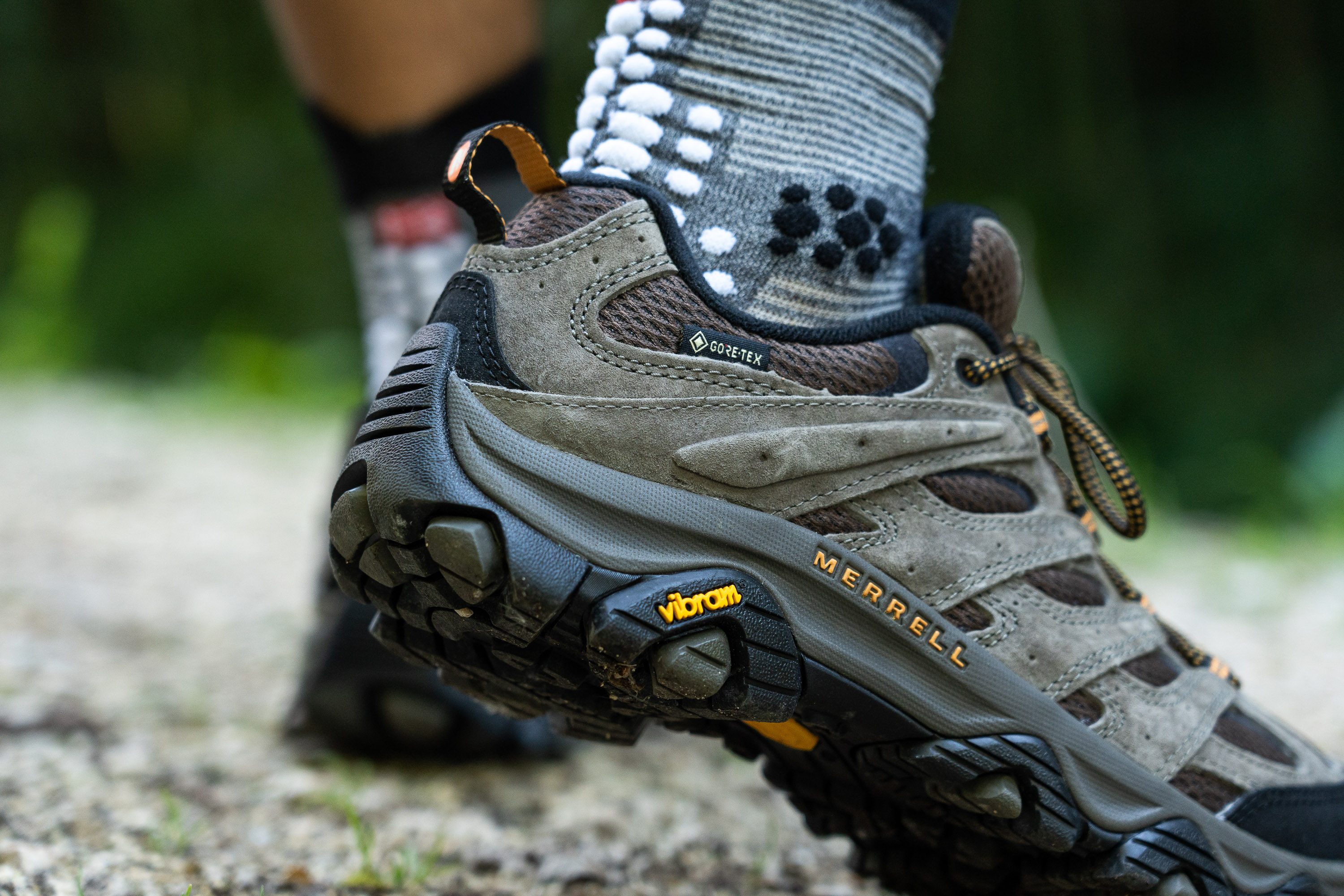
We examine it by squeezing it and pushing it while in our lab. We give it a 1-5 rating, where 5 is the stiffest.
Assessing the stiffness of the heel counter in a backpacking shoe
Durability of backpacking shoes
Durability is always an important feature in footwear. In hiking, however, it’s not only about how long will the backpacking shoe last, but also:
- The durability of the toebox tells us how much protection the toebox offers for our toes. The debris we encounter on the hike or that falls accidentally on the toebox should not hurt our toes.
- The durability of the outsole tells us not just how long will the grip (the lugs) last, but how protective it is. The denser and harder outsoles are less likely to be destroyed by sharp objects on the trails.
- The durability of the heel counter, just like in any other shoe, tells us how long until that part is left with no materials to cushion the heel or at least will it wear out sooner or later.
Pressing a Dremel on the upper to test the durability of the toebox
For these durability tests, we use a Dremel. We press it against the material and note down the damage. When testing the upper, we assess the damage on a 1-5 scale, where 1 is the least durable.
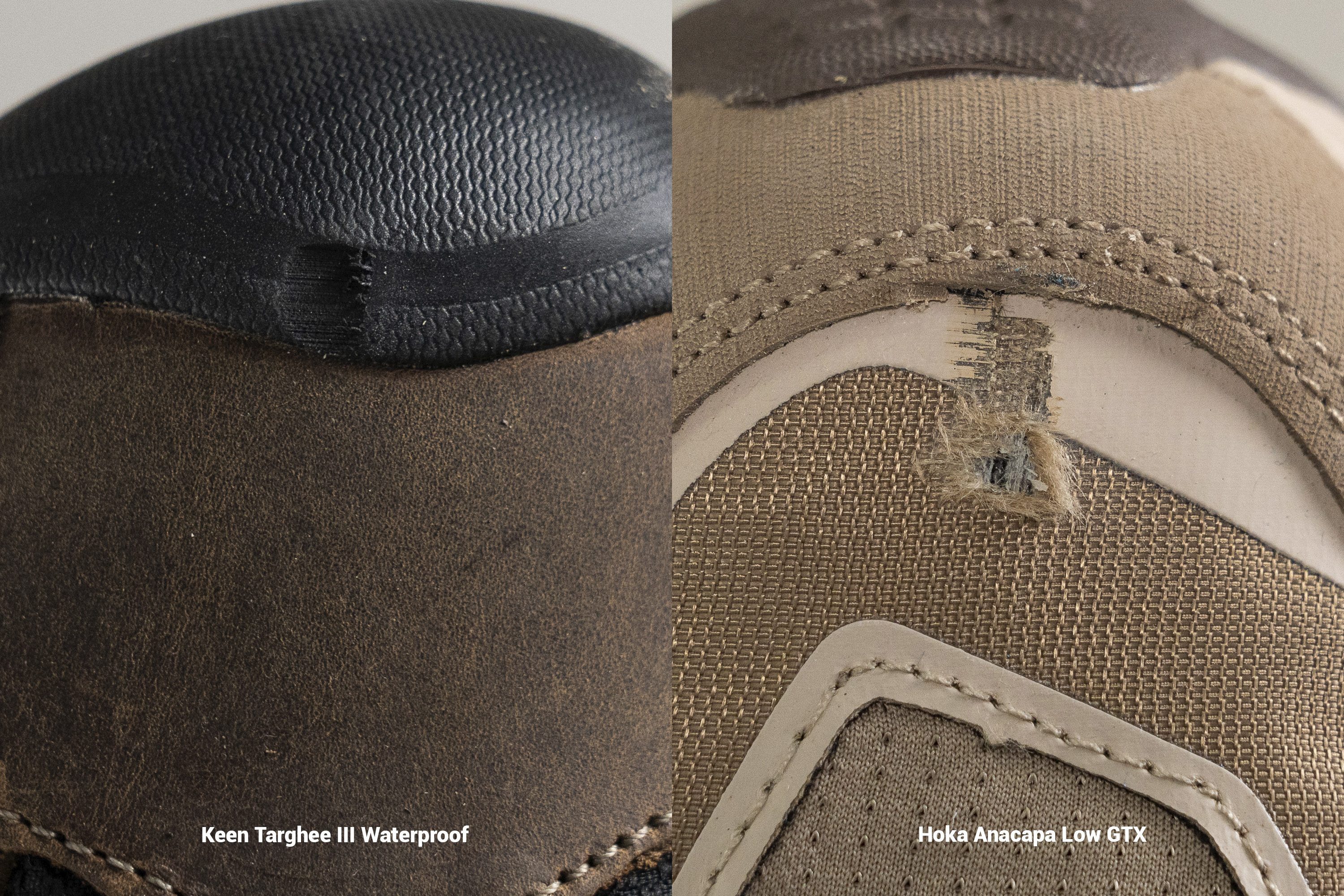
When testing the heel counter, it is the same - we rate it on a 1-5 scale, and 5 is a dream come true: the most durable one.
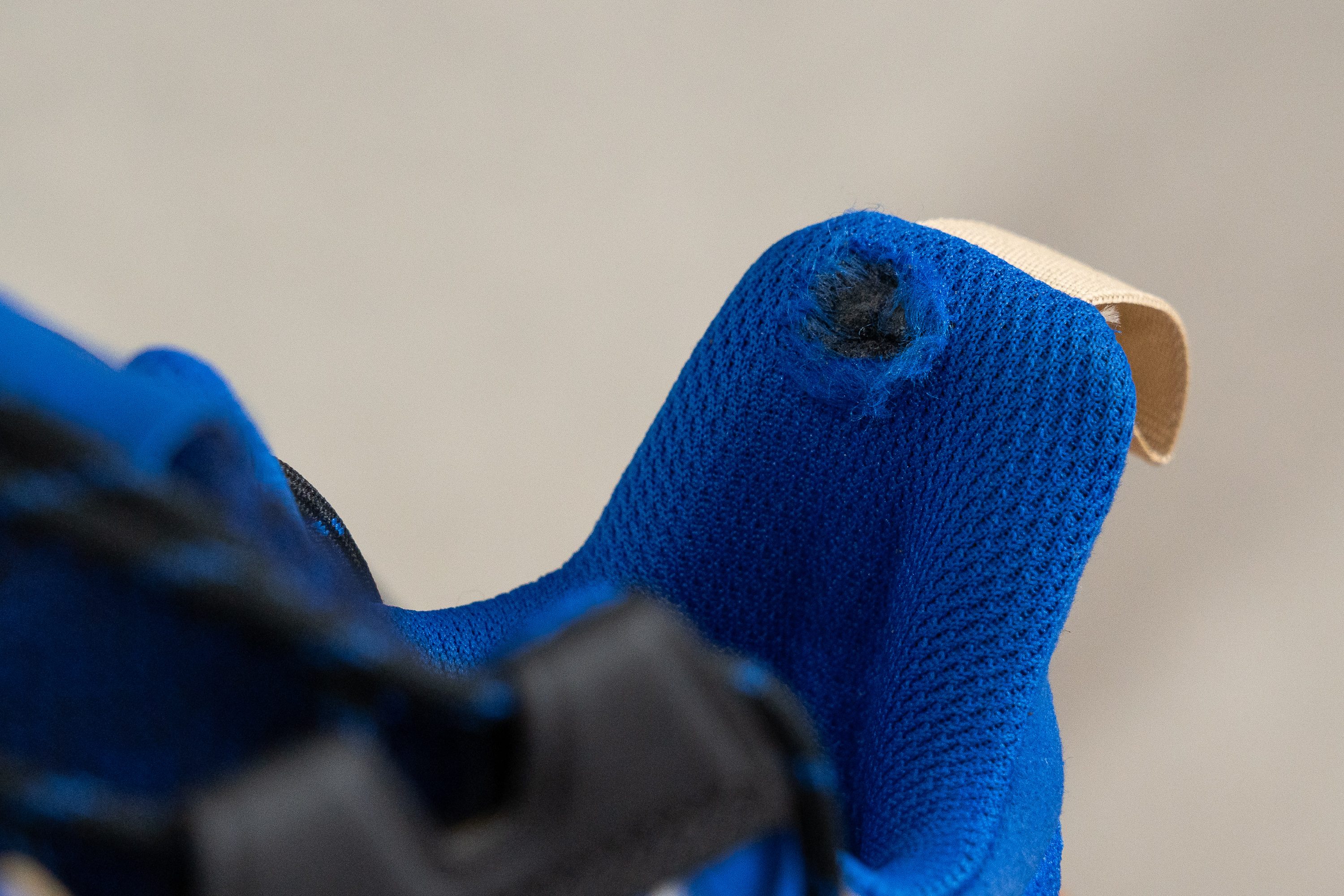
When testing the durability of the upper, we can actually measure the damage using a tire tread gauge.
Pressing a Dremel against the hiking shoe outsole to test its durability
We measure the dent made by the Dremel and, the larger it is, the less durable the outsole rubber.
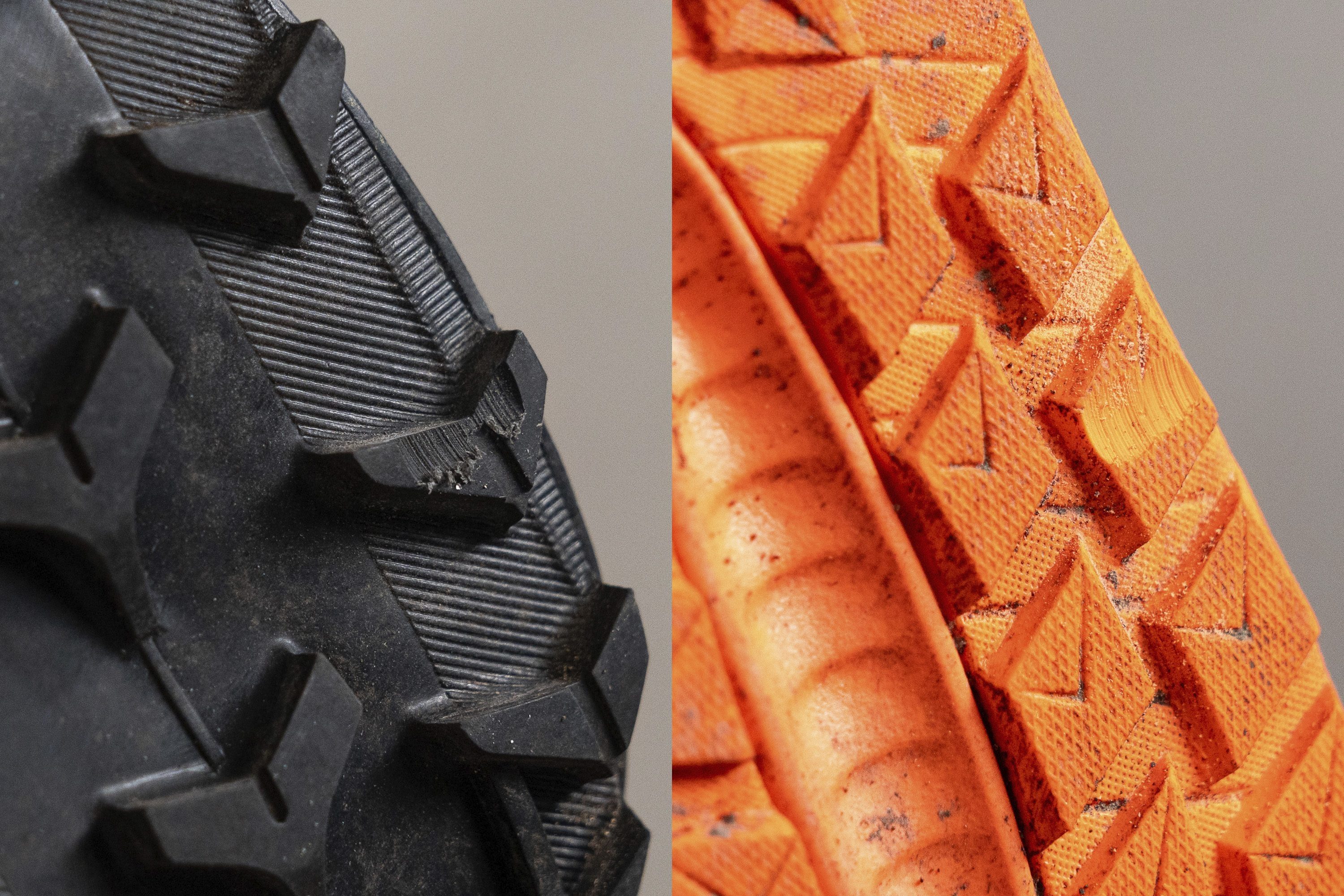
Look for superb grip and don’t settle for less than that
Slipping, sliding, rolling… to prevent that, it’s best to look for the shoe that will offer a brutal grip on the terrain you’re covering.
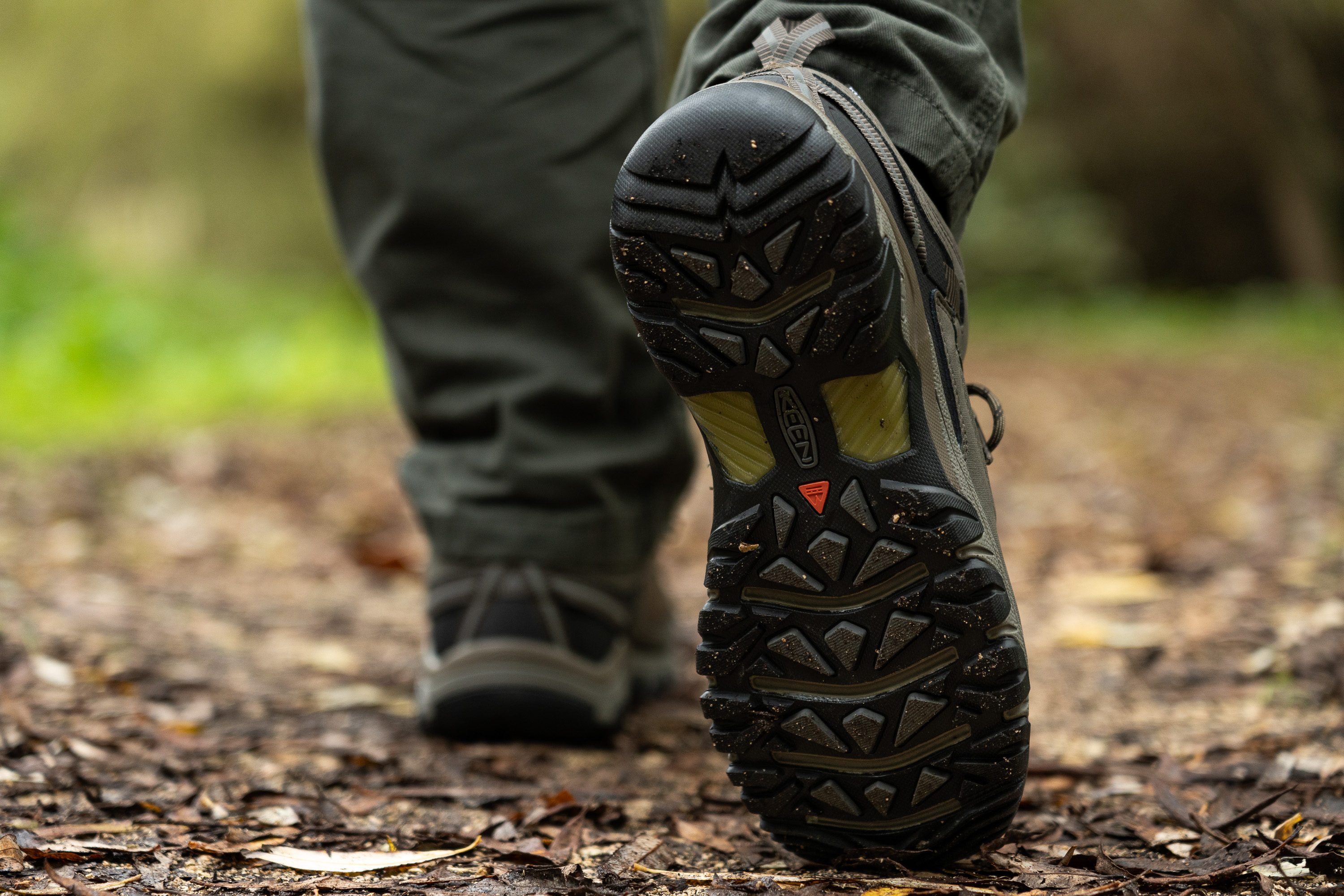
Here’s what we suggest:
- If hiking in wet weather, meaning there’s mud, slush, snow, look for backpacking shoes with very deep lugs (4mm or deeper).
- If hiking on large, flat rocks (or very hard ground), look for shallower lugs. Such shoes will hurt your feet less, and shallower harder lugs will last longer on such terrain than the soft large lugs. We’re talking about a depth of up to 4mm.
- For anything in between or a bit of everything but nothing too extreme, look for average lugs (around 4mm).
In all our reviews, you can find the exact depth of the lugs and how it compares to the averages. We use a digital caliper to measure how thick the lugs are.
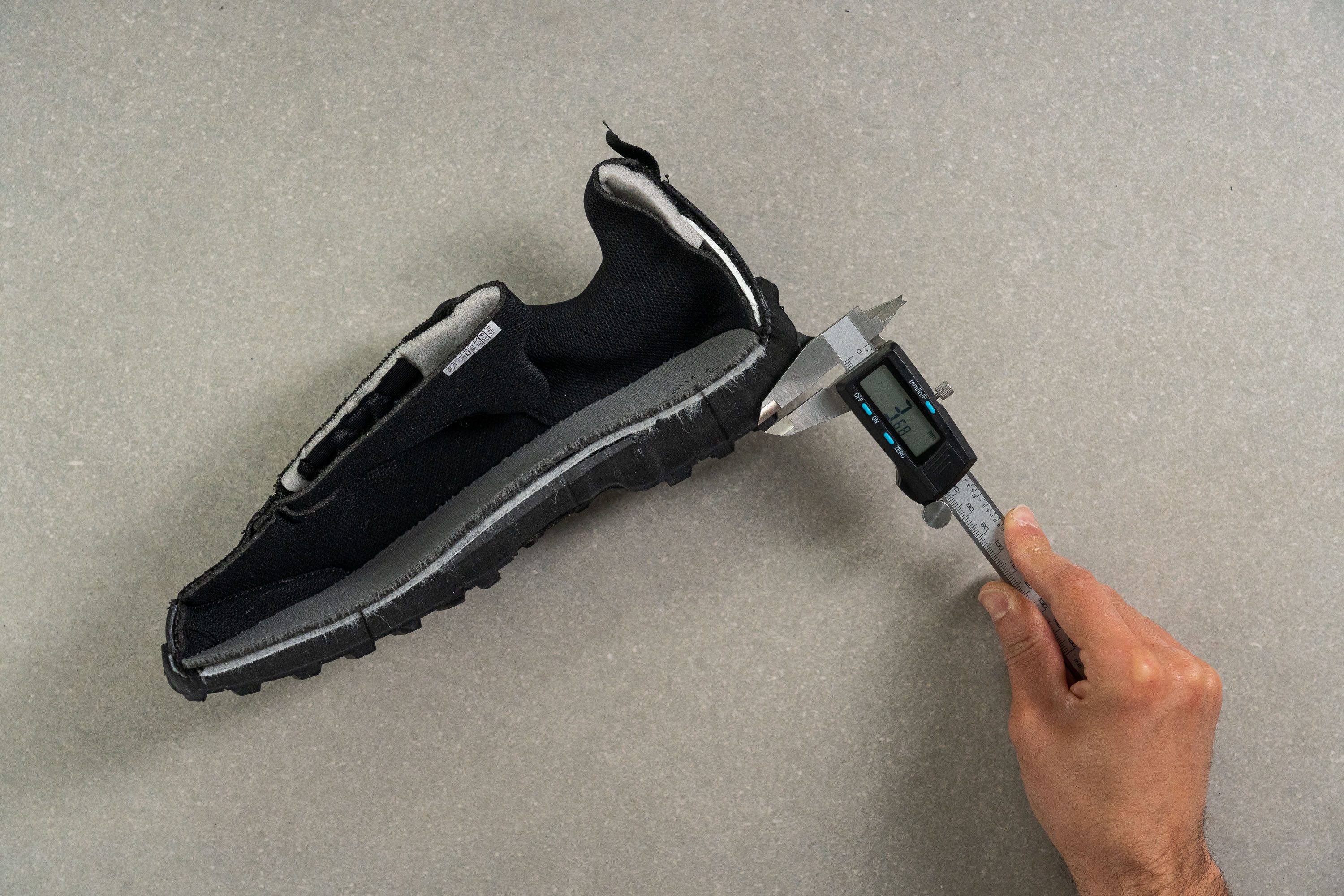
Keep in mind though, that, the grip is not only about the thickness of the lugs, but also the hardness of the rubber. The harder rubber is more protective, while softer rubber is stickier. We also measure this in our lab.
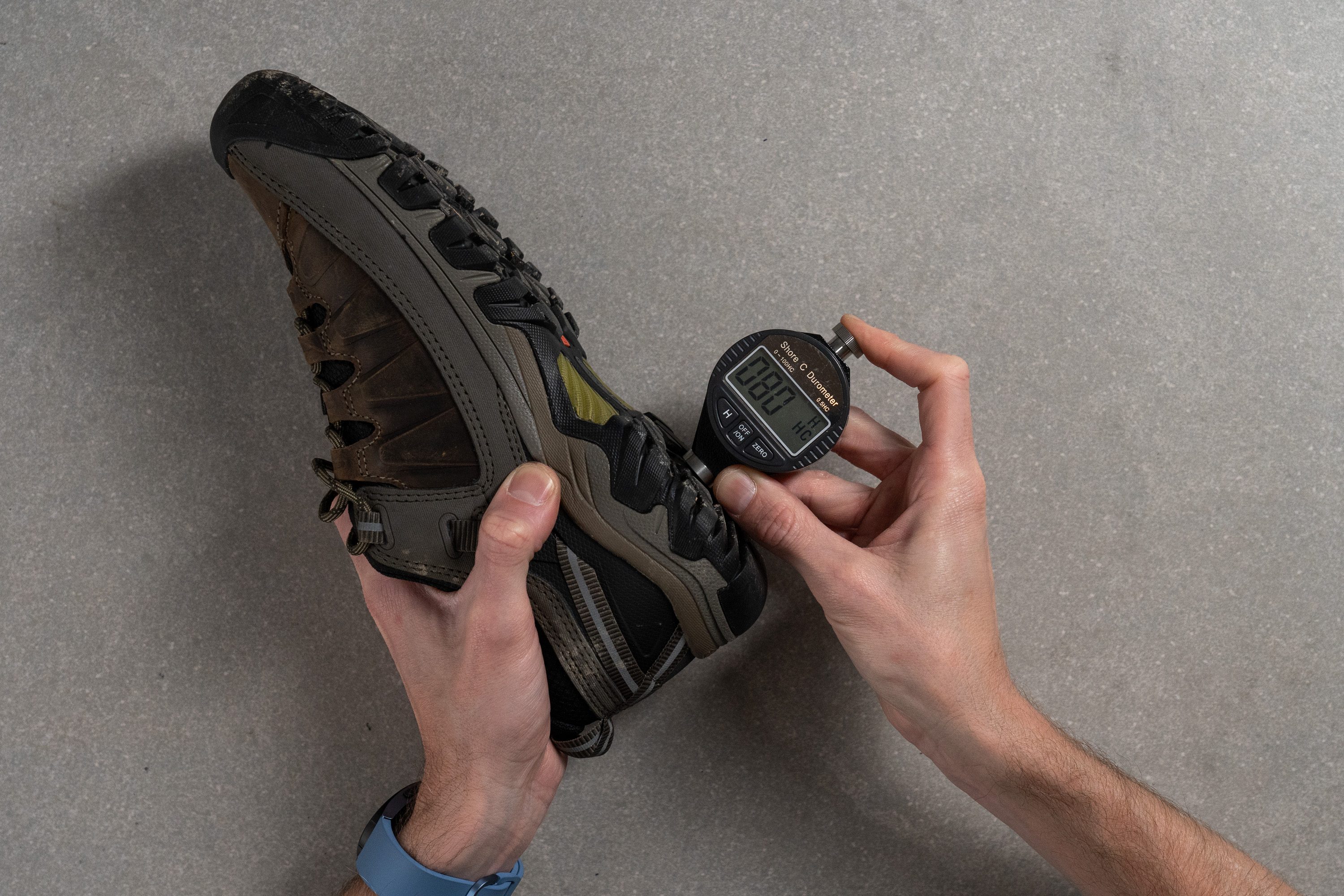
Wide toebox in backpacking shoes
Given that backpacking usually entails multi-day hikes or, at least, long mileage over 1 day, your feet will swell and that means you might need more room there. Or, you actually have wider feet that ask for a wider toebox.
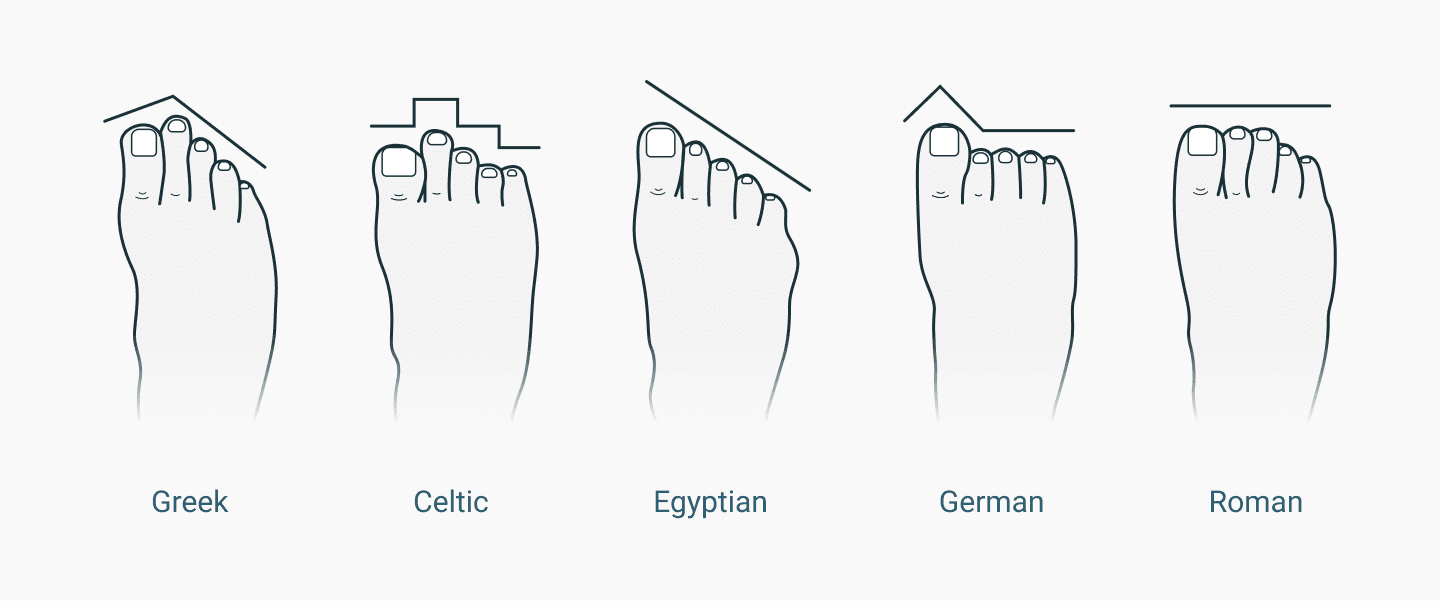
No worries because in our lab, we measure the width of the toebox, which is the widest, and around the big toe. Both measurements are important because there are different shapes of toes out there. But, the smaller the big toe number, the more the shoe tapers. Or, it’s pointier.
In our lab, we pour a special gel into the backpacking shoes, freeze it, and then measure its width because it perfectly represents the interior of the shoes
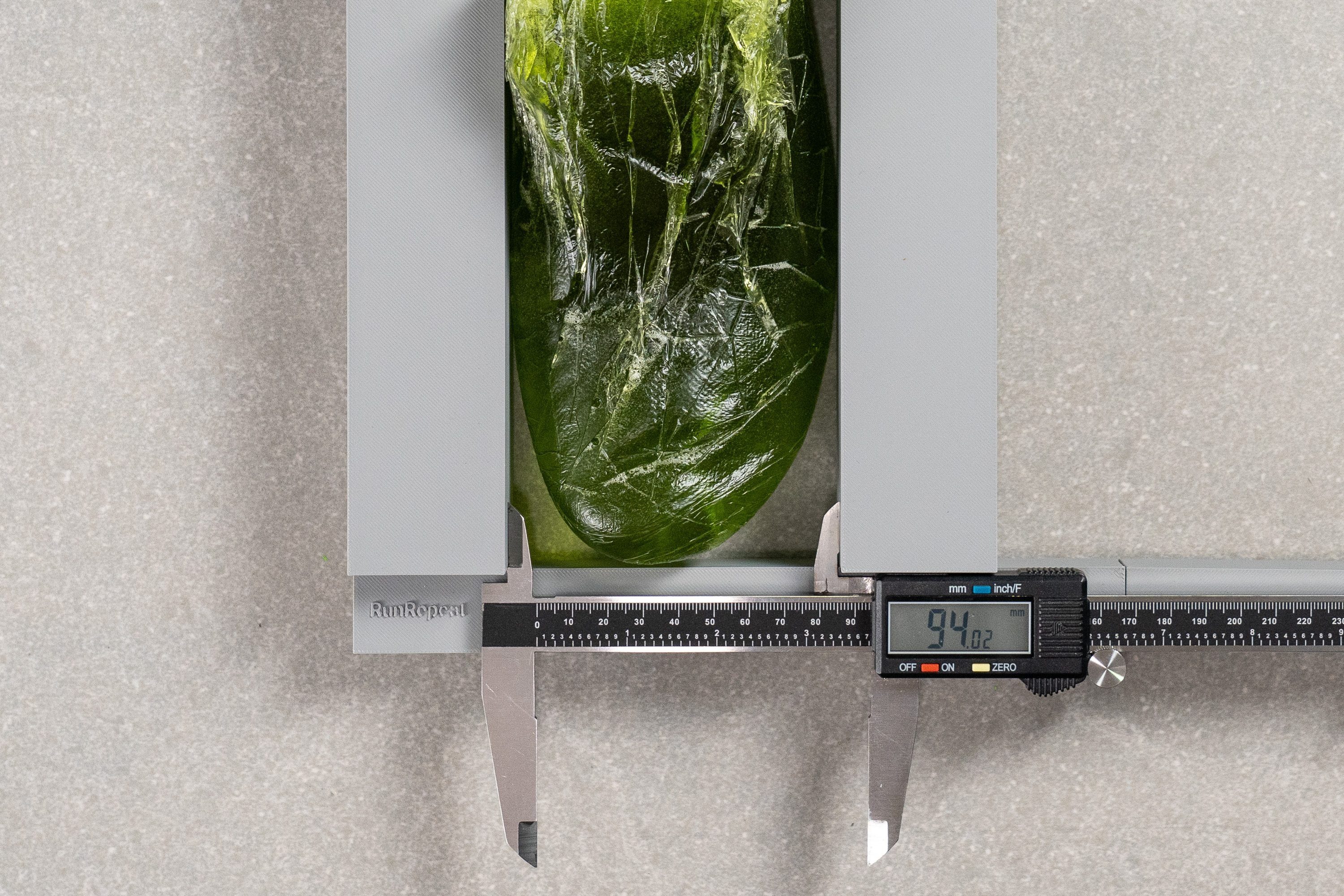

Some hikers also need vertical room, not just horizontal, and they can always consult our reviews because we measure that as well.
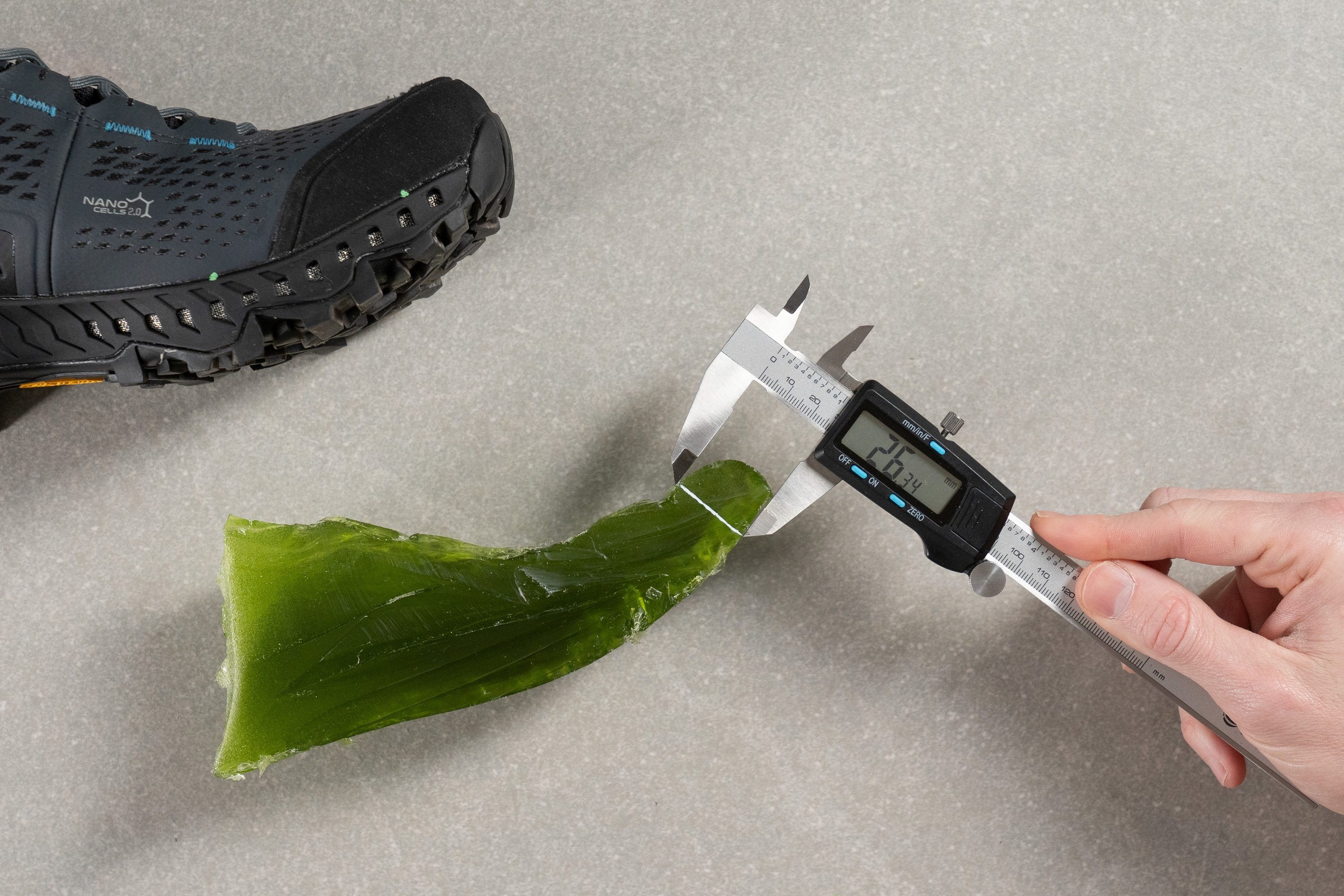
Breathability of backpacking shoes
If hiking in summer, you want to know about this. If hiking in winter, same, but then you also want to know about waterproofing (next chapter).
In the lab, we examine the breathability by pumping the smoke into the shoe and looking at the smoke coming out: does it come out, where it comes out, at which pace and how much of it.
Non-breathable hiking shoe (left) and a breathable one (right) on the smoke test
In breathable hiking shoes, we see it come out through the upper and the sides. In less breathable shoes (or not breathable at all), it might come out through the eyelets only. Based on these, we rate the breathability on a 1-5 scale, where 1 is the least breathable.
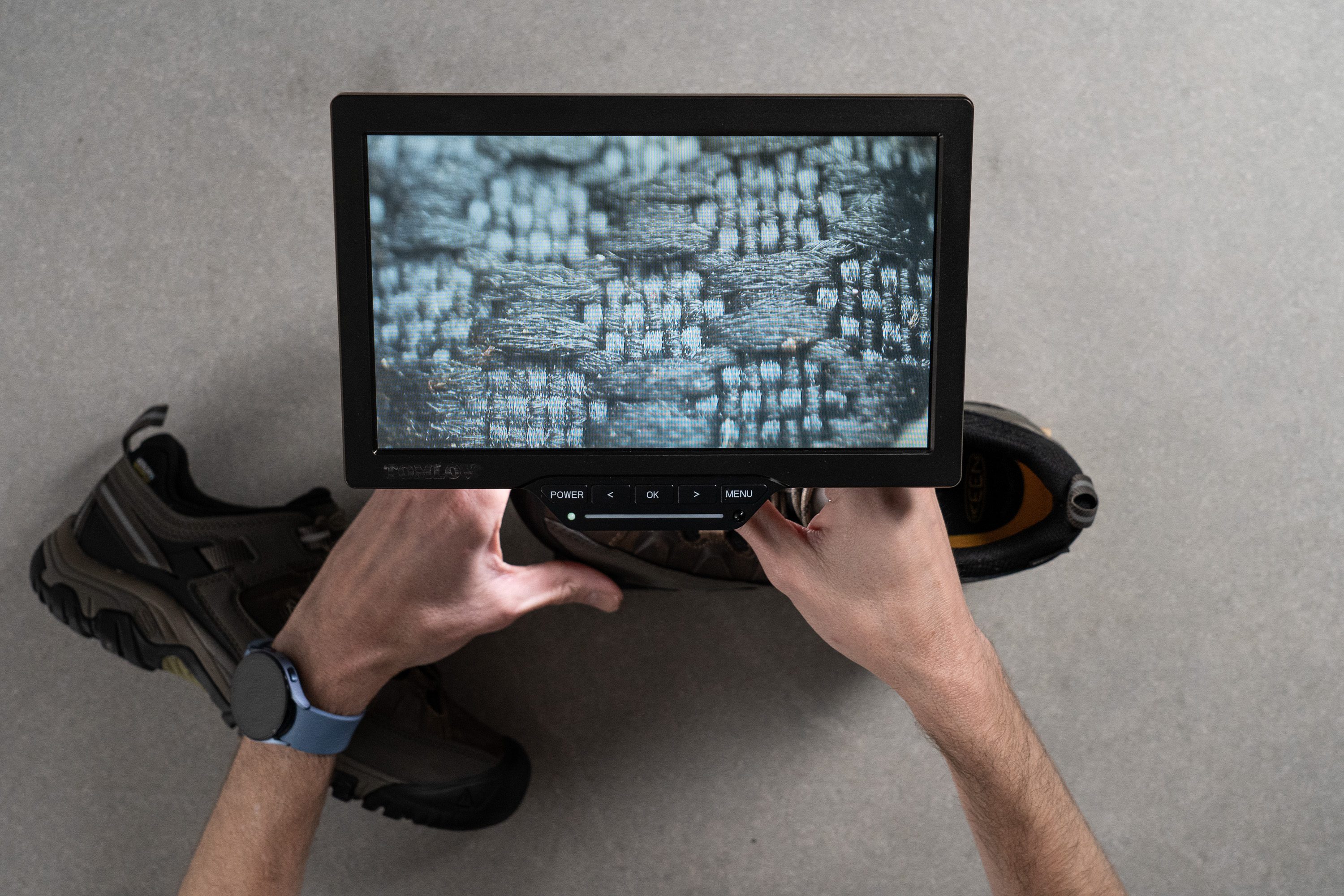
We also examined the upper under the microscope, and we noticed how the breathable uppers have a looser structure, while the non-breathable ones have a very tight, dense structure.
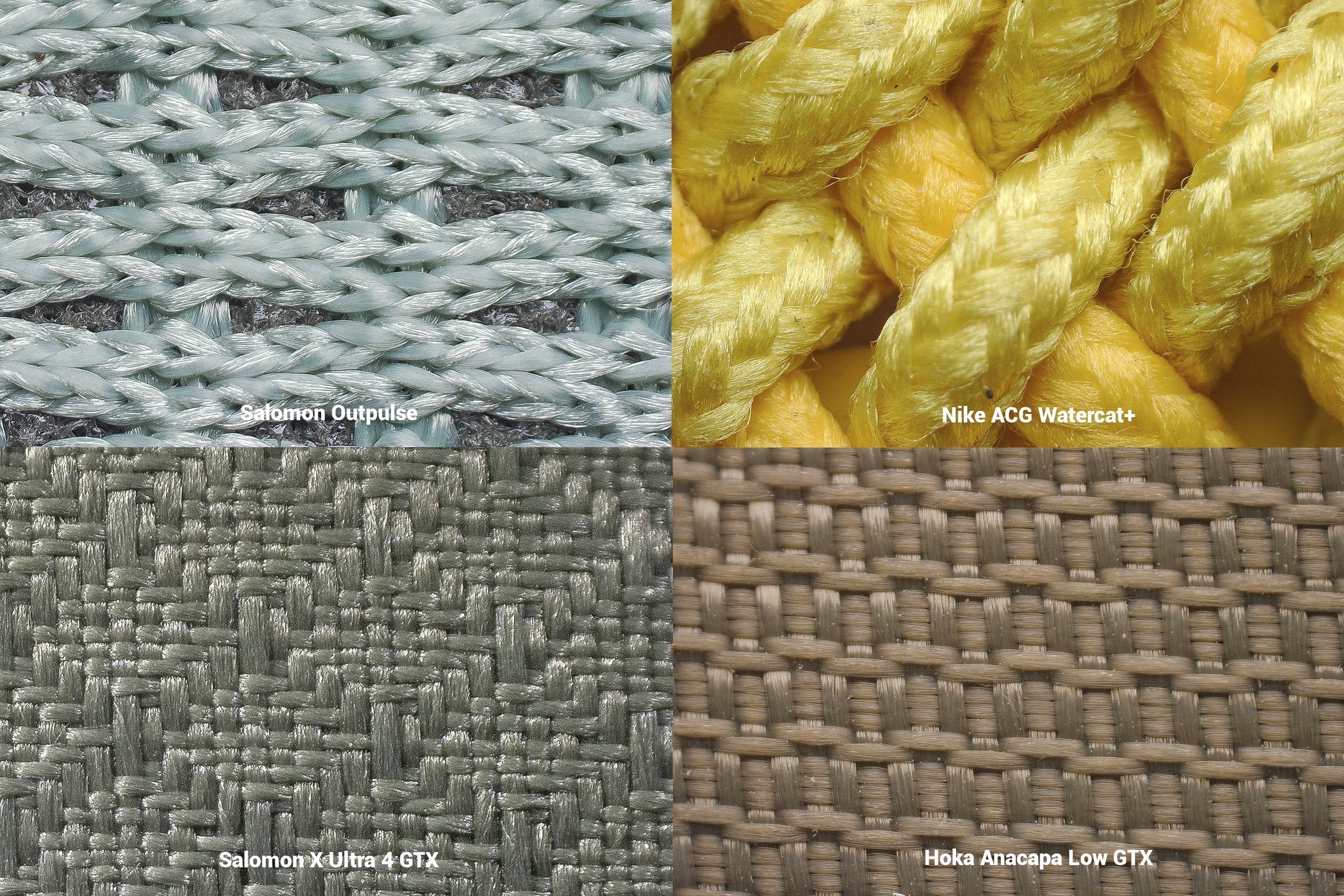
Shoes that have their breathability rated as 1 or 2 are great for cold temperatures because the heat will not escape outside. The shoes rated with 4 or 5 in breathability are great for summer because they turned out to be quite breezy.
Best backpacking shoes for winter
In winter, it's not just about the breathability. As mentioned above, backpacking shoes we find winter-friendly are those that score low on the breathability test (rating of 1 or 2) because they are not ventilated enough, which means the heat stays trapped inside.
But, what's also important is whether, at freezing temperatures, the backpacking shoe performs similarly to when it's at room temp. Meaning: does the shoe feel like a brick when it's very cold? No one wants that!

Here's how we examine this. First, we put the shoe in the freezer for 20 minutes. Then we test its flexibility and softness again and compare the numbers to those measured at the room temp. Smaller differences in % mean that the shoe does not change its performance and feel much. Very big differences in % should be a sort of a red flag.
When to use waterproof backpacking shoes
Only when you know you will actually need them: you plan to hike over very wet grass or there might be some rain on the hike.
Pros of using waterproof backpacking shoes:
- Your feet will stay dry if you encounter some wet areas or wet weather
- Used with waterproof gaiters, these shoes can do wonders in terms of waterproofing! The gaiters will keep your lower legs and ankles dry as well, and they wonderfully prevent the water (slush, mud) from getting into the shoes.
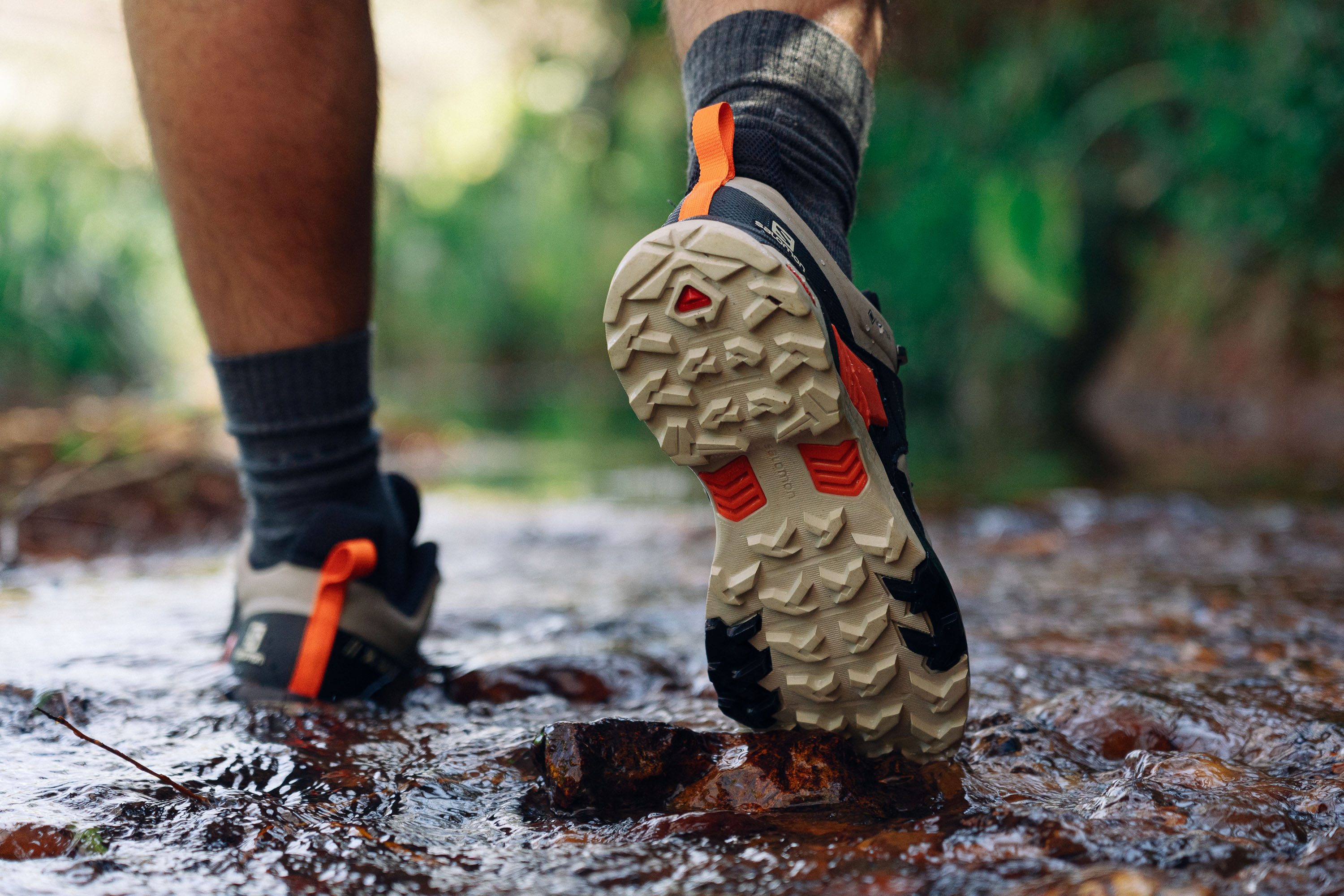
Cons of using waterproof backpacking shoes:
- These shoes don’t breathe, so your feet might sweat more than usual
- It’s easy for water to get into your shoes as it might slide down your legs/trousers, or the water area might be too deep, so the water gets in through the eyelets or simply over the heel counter
- If the water gets in somehow, blisters are the best-case scenario (the water can’t get out)
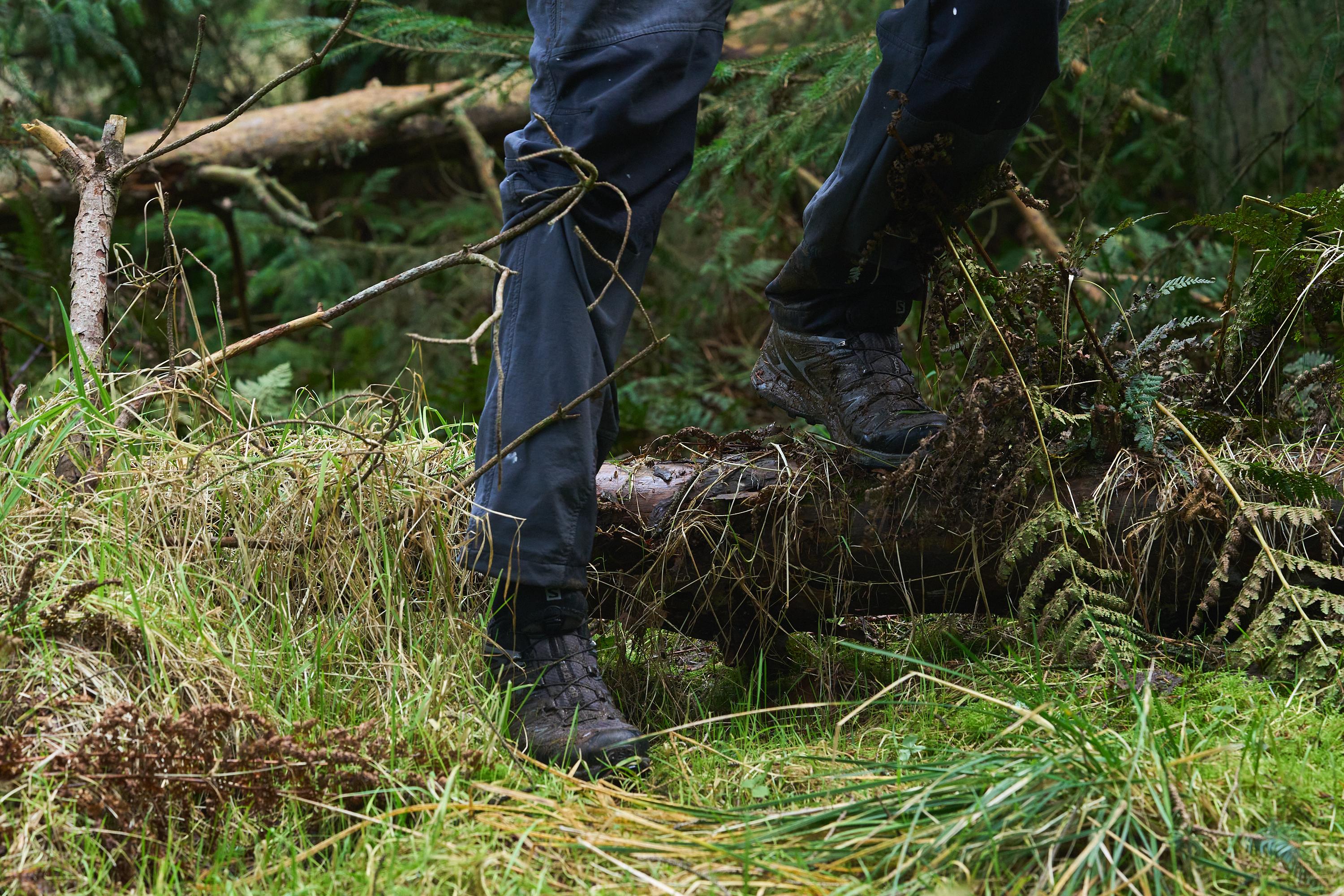
Waterproof hiking shoes are easy to recognize, either they have the popular Gore-Tex (GTX) membrane, or they are clearly marked as Waterproof.
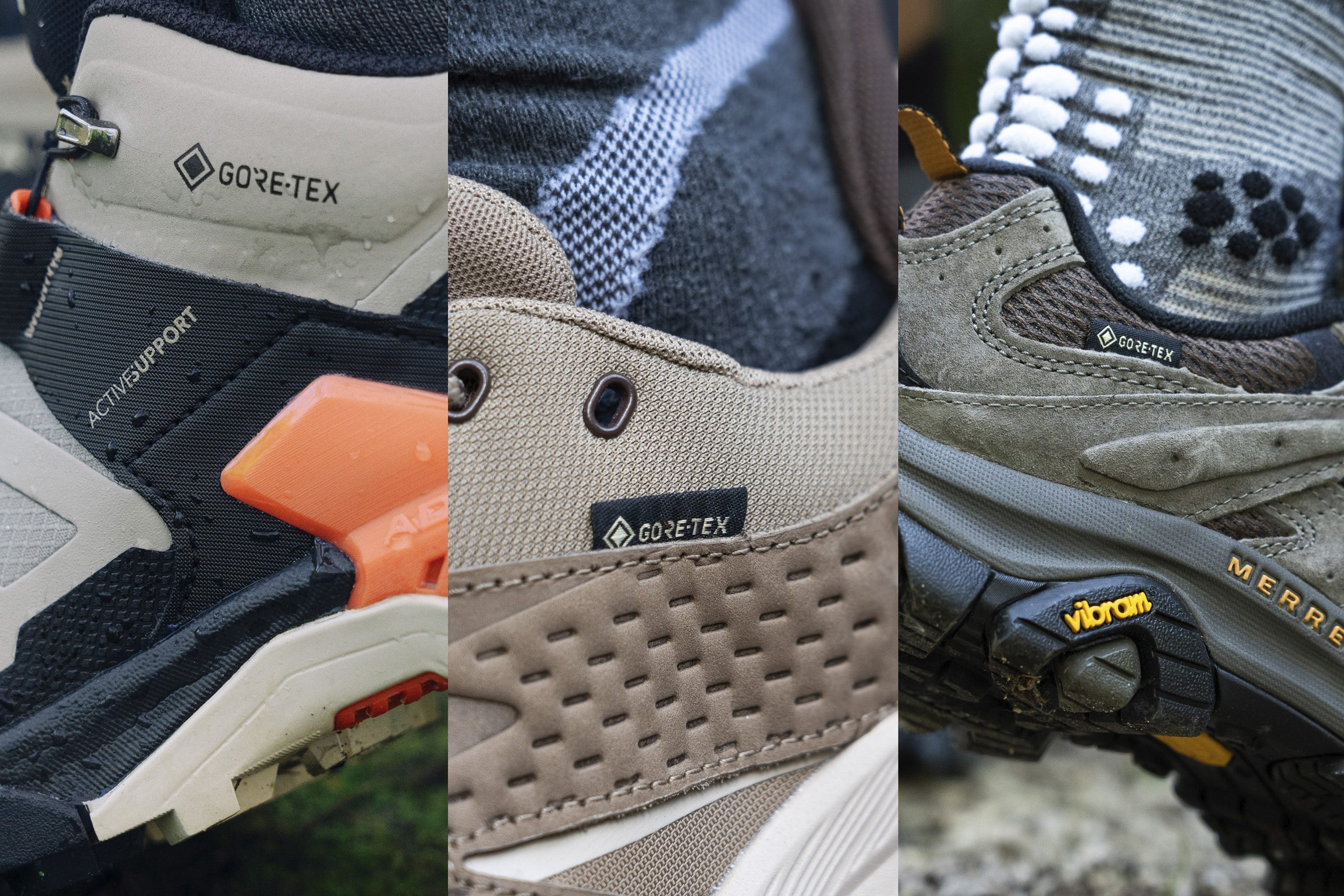

You might be ok with hiking shoes that are only water-resistant or water-repellent. In that case, no need to invest in waterproof material. Here’s how to make that decision based on the weather conditions:
| Water-resistant | Water-repellent | Waterproof | |
| General characteristics | a tightly woven fabric that is naturally capable of resisting water upon contact | fabric treated with durable water-repellent (DWR) or hydrophobic chemicals | - fabric treated with DWR - have waterproofing membranes like Gore-Tex and OutDry - have seam-sealed construction for extra protection |
| Water protection level | low water protection | moderate water protection | high water protection |
| Water pressure resistance | 0-5000 mm (no pressure or moisture) | 6000-10000 mm (light pressure) | 10000-20000 mm (high to very high pressure) |
| Weather conditions best used in | light rain shower and dry snow | light rain and average snow | moderate to heavy rain and average to wet snow |
If you decide to use waterproof shoes, we advise also getting wool or bamboo socks. They have moisture-wicking features and tend to keep you warm when it’s cold and cold when it’s warm.

